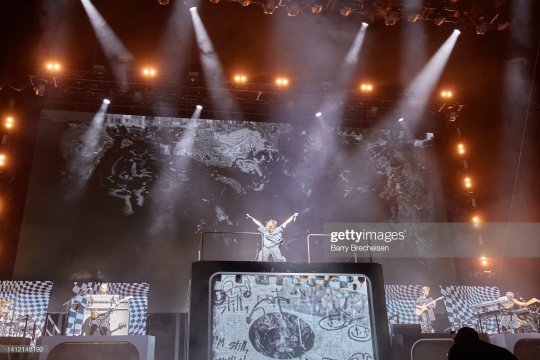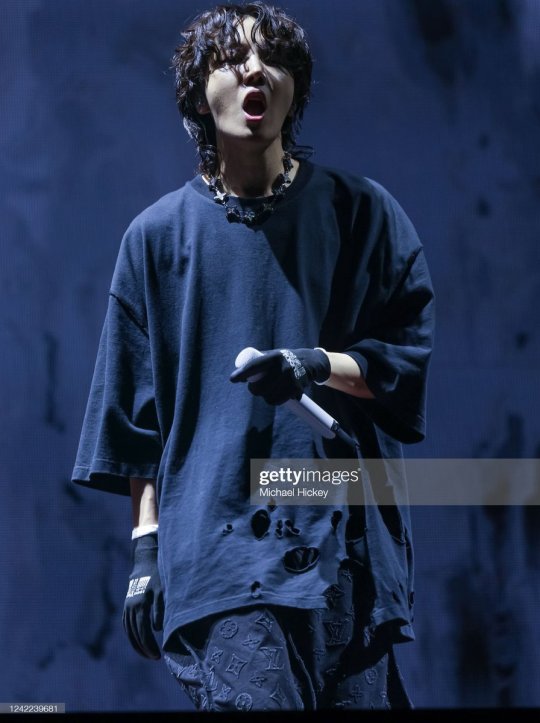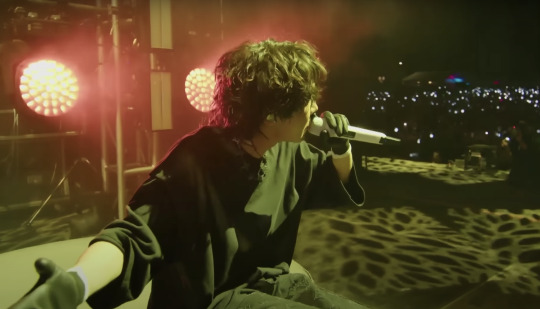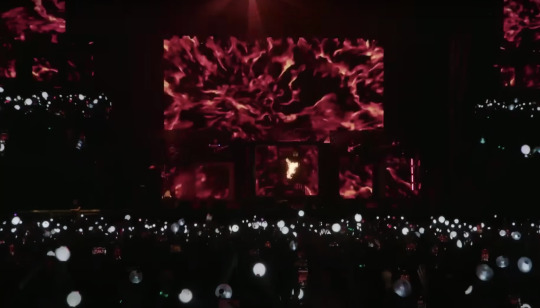Text
j-hope at Lollapalooza- the journey of a star
Preface: this write-up is focused on the first half of j-hope's set (before Music Box: Reflection)
For his inaugural solo set, j-hope made his entrance by leaping out of a giant box. It was both a literal nod to the 'Jack in the Box' toy mechanism that inspired his latest titular album, as well as a figurative statement on breaking out of the mould of 'j-hope of BTS'. This grand gesture served as an introduction to the themes of his work and a declarative statement on the kind of artist he aspires to be. It prepared the audience for a journey of shock, surprise and delight.
The production read like a theatre play. Before j-hope made his entrance, it started with the introduction/prologue consisting of a soothing female voice telling the fable of 'Pandora's Box'. This effectively set the tone of a twisted children's tale, eccentric and slightly creepy. It was reinforced through the set design and projection of graphics, which had a scrawled, child-like feel in bright colours (reminiscent of artist Cy Twombly or Jean Michel-Basquiat) and checkerboard graphic. The whimsical feel was tempered by the darkness of night and mostly black background.

Credit: Getty Images
In his interview with IU prior to the show, he said, "you'll get to see a side of j-hope that wasn't there before, and you'll be able to feel what I feel and see the world as I do". j-hope had a story and vision and he was here to execute it. He was simultaneously an artist painting the scene, a storyteller through his lyrics, and an actor that draws the audience in through raw display of emotions. Many times he felt like a conductor, superbly skilled at using arm gestures to direct the crowd's attention and to seemingly command the live band. He played the role of a mad artist and creative genius, drunk on his own work, while also being the main protagonist of the story.
The first act of his 'play' started with 'More', a song expressing feral thirst and ambition. It is that ceaseless hunger that has led j-hope to this very stage. His performance showed a side that had not been fully been explored until now. Abandoning dance choreography that marks typical 'kpop' performances, he instead threw himself into the song with wild abandon, including headbanging, stumbling, and facial expressions that flitted from despair, agony to pure enjoyment of the stage. In short, he appeared unhinged and even possessed by an inner demon. It was akin to a work of performance art. This was Jack coming out, his darker side. It was also the 'Jay' to his 'Hope', marking a return to rap and a departure from the wholesome pop star image. Fittingly, his voice was gritty and loaded with emotion.
Kpop performances are highly visual and often feature lavish outfits. In a bold move, j-hope dialled back on his costume by choosing an all-black ensemble of T-shirt and cargo pants. It gave subtle punk-rock vibes mixed with Goth- very fitting for the live band and the overall soundscape and aesthetics of the earlier half. j-hope's dark hair was grown-out with tousled curls, adding to the raw feeling. By removing the slick polish of kpop, j-hope was sending a clear message- he wanted the focus to be squarely on his music and stage presence. As the hour flew by, his hair and clothes would get mussed up, and this was all part of the experience. It conveyed a sense of authenticity that would resonate with an alien crowd. By eschewing choreographed dance in favour of seemingly freestyled moves, he further created an authentic reaction and connection with the music.

Credit: Getty Images
We can consider the breaks that j-hope built within the performance as divisions between acts. He has an astute understanding of pacing, and knows how to create ebbs and flows. A prime example of this is the way he commanded the audience to 'sing it!', creating a spontaneous live choir of people reciting 'Hangsang with my dawg right... smash on the street'. Through physical gestures, audience interaction as well as the cadence of his voice, he builds tension leading up to the climax. Then he comes to a halt, drawing all focus to him, before launching into arguably the most memorable verse of the song. With Hangsang as the conclusion to the first act, after addressing the audience he embarks on the second act which explores concepts of peace and equality in the world. In 'Piece of Peace', 'Equal Sign' and most intriguingly 'STOP (There are no bad people in the world), he ponders on his role amidst social issues and the daily barrage of news.
The dreamlike song 'Blue Side', made even more haunting by the live instrumentals, served as an interlude. It was both designed as a break for j-hope to catch his breath, as well as a shift in the mood of the narrative. His thin figure silhouetted against the blue sea of light, he conveyed a sense of fragility and pensive emotion. The following song, 'Safety Zone', marks the start of the third act with j-hope seated on a small podium to the side. Basked in light, it felt like his own bubble and safe corner. While j-hope was radiating energy outwards earlier and addressing larger issues in the world, now he seemed to withdraw slightly and focus on his inner state. This was complemented by the camerawork, which switched to more close-up, lingering, intimate shots of him. The introspective lyrics made it akin to a monologue, and it was hypnotizing to watch him get lost in the moment.


It is fitting that the epic conclusion to the third 'act' was Arson, the title track from 'Jack in the Box'. 'I burned it all' and 'it's done', he proclaims in the song. Fire has always been a powerful symbol- it conjures up feelings of danger, it is necessary for life yet could also hearken to images of hell, death and destruction. In j-hope's case, this was a necessary demise for his subsequent rebirth. His wild passion is an all-consuming force that leads him to seemingly destroy the stage (and possibly his stable self) through violent motions. He is demolishing stereotypes of himself and his past image as a 'kpop idol', in order to emerge as a new person and become the artist of his choice.
The willingness to let go of his conscious self while retaining control of the audience separates j-hope from other performers, and transforms his Lollapalooza set into a masterful work of art. As the music swelled into an explosive section with drums, j-hope completely let loose on the elevated platform. The visual projection at the back gave him the appearance of being completely consumed by flames. The cathartic release of pure energy felt like a supernova- a giant explosion marking the death of a star. This cataclysmic event generates shockwaves so huge that it could trigger the formation of new stars.

In the lyrics of Arson, j-hope ponders, "Now I ask myself, choose what? Do I put out the fire, or burn even brighter?" It remains an open question, but perhaps his performance provided the answer. On that night, we as an audience witnessed both the end and the birth of a star. Pandora's box was now open; everything within him had been unleashed and it could never be closed again.
#jhope lollapalooza#jhope#jhope jack in the box#jhope arson#bts#jung hoseok#hoseok#hobi#hobipalooza#jack in the box#hope world#jhope more#jhope bts
9 notes
·
View notes





